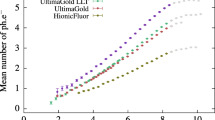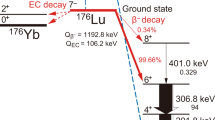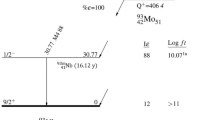Abstract
As an alternative to the common gas sample methods for radiocarbon dating, liquid scintillation counting has been used and is being improved on. Relatively recently, a practically complete synthesis of benzene, one of the most efficient liquid scintillation materials, has been developed in Texas1,2 and, independently, in the U.S.S.R.3. The liquid, containing 92 per cent carbon, all of which comes from the sample being dated, can be produced in approximately 50 per cent yields in 8 h or less. The liquid scintillation counter, now in widespread use in biological and chemical tracer work, is well known for its exceptional reliability. Improvements in the photomultipliers and the introduction of fast electronics, which have substantially reduced the resolving time of the coincidence unit, have increased the counting efficiency for radiocarbon to 75 per cent or more. This is comparable to the gas sample counters. The stability of the liquid scintillation counter seems to be as good as that of the best gas counters.
This is a preview of subscription content, access via your institution
Access options
Subscribe to this journal
Receive 51 print issues and online access
$199.00 per year
only $3.90 per issue
Buy this article
- Purchase on Springer Link
- Instant access to full article PDF
Prices may be subject to local taxes which are calculated during checkout
Similar content being viewed by others
References
Tamers, M. A., Stipp, J. J., and Collier, J., Geochim. Cosmochim. Acta, 24, 266 (1961).
Noakes, J., et al., Geochim. Cosmochim. Acta, 27, 797 (1963).
Starik, I. E., et al., Radiokhimiya, S.S.S.R, 3., No. 1, 101 (1961).
Suess, H. E., Science, 120, 5 (1954)
Barker, H., and Mackay, J., Radiocarbon, 3, 39 (1961).
Barker, H., and Mackay, J., Amer. J. Sci., Radiocarbon Supp., 1, 81 (1959).
Tamers, M. A., Pearson, F. J., and Davis, E. M., Radiocarbon, 6, 138 (1964).
Tamers, M. A., I.V.I.C. Natural Radiocarbon Measurements, I, Radiocarbon, 7 (in the press).
Pearson, F. J., Davis, E. M., Tamers, M. A., and Johnstone, R. W., University of Texas Radiocarbon Dates, III, Radiocarbon, 7 (in the press).
Author information
Authors and Affiliations
Rights and permissions
About this article
Cite this article
TAMERS, M., PEARSON, F. Isotope Effect in the Benzene Synthesis for Radiocarbon Dating. Nature 205, 1205–1207 (1965). https://doi.org/10.1038/2051205a0
Published:
Issue Date:
DOI: https://doi.org/10.1038/2051205a0
This article is cited by
-
New ultra-sensitive radioanalytical technologies for new science
Journal of Radioanalytical and Nuclear Chemistry (2018)
-
Validity of Radiocarbon Dates on Bone
Nature (1965)
Comments
By submitting a comment you agree to abide by our Terms and Community Guidelines. If you find something abusive or that does not comply with our terms or guidelines please flag it as inappropriate.



